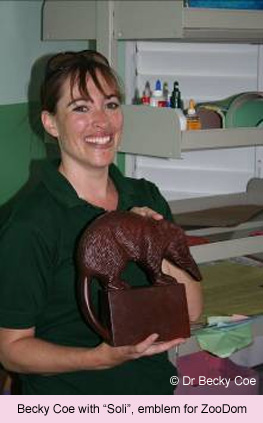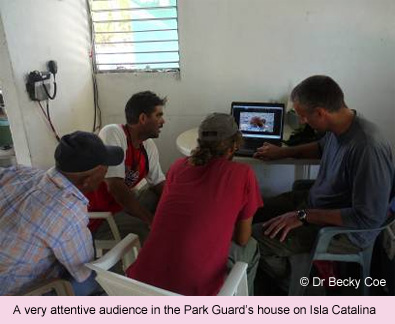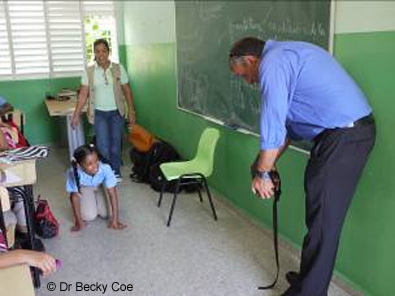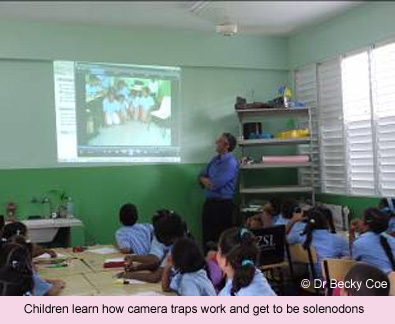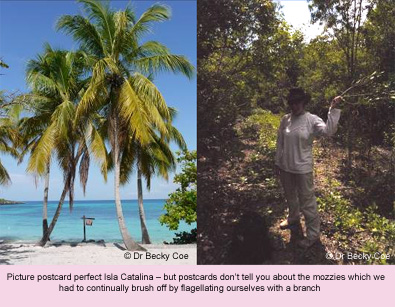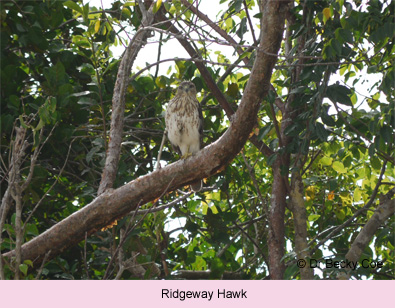Hello! My name is Dr Becky Coe, I have been working for ZSL London Zoo as an Education Officer for the past three and a half years – and finally seized an opportunity to visit a field-based conservation project. Thanks to ZSL’s Michael Brambell Travel Award I was able to spend three weeks in the Dominican Republic assisting on “The Last Survivors” project which aims to conserve not one but two EDGE species – the Hispaniolan solenodon and hutia.
It was an excellent introduction into the multi-faceted nature of conservation work. Obviously I knew it wasn’t just a case of putting a fence round some furry little critters and sitting back to let them get on with it, but I perhaps wasn’t aware of how difficult it is to strike a balance, of how many activities compete for your time – and energy – and how gently you must sometimes tread. I must add here that the Project Managers of “The Last Survivors” are doing an extremely admirable job. From imaginative ideas of engaging local business people to ensuring in-country research assistants are trained in field techniques; from fund raising to talking to schools; from investigating the attitude of people in direct contact with an endangered species to finding time to actually study the species itself.
I was primarily in the Dominican Republic to apply my background in Education to raising awareness for the solenodon and hutia. Sadly, Communication, Education, Participation and Awareness (“CEPA”) is sometimes a “poor cousin” in the world of conservation, added on to projects as a bit of an after-thought. But for the long term survival of a species what could be more important than letting the people who share their space know about them and their precarious existence? Why else should they care? Why should they support, financially or otherwise, protection of something they don’t know about?
From what I have seen on the project, in this instance simple awareness-raising is the place to start. Mention a solenodon or a hutia and you tend to be met with a blank look, so people cannot begin to know that their island is home to two unique terrestrial mammals found nowhere else in the world (not to mention various endemic birds, beetles, frogs and plants). To start to tackle this, I , Joe Nunez-Mino (my glamorous assistant and translator) and Jorge Brocca spoke to seven school groups, three universities, the staff of ZooDom (the National Zoo in Santo Domingo) and even to an audience of three in the Park Guard’s hut on Isla Catalina. We variously spoke about the solenodon and hutia, demonstrated field techniques, and discussed the role of a modern zoo.
These presentations also gave the opportunity for Ivelisse Diaz Sosa, Director of Education at ZooDom, and her team the chance to observe some techniques for engaging different audiences. Ivelisse has lots of ideas, and boundless enthusiasm, for incorporating solenodons (incidentally, the logo of ZooDom) into their education program, so in the longer term awareness-raising will continue. There is also a need for more targeted communication, creating a dialogue with the people who come in direct contact with “The Last Survivors”. Finding out, for example, why villagers’ dogs are allowed off the leash at night (when they have been known to attack solenodons and hutias) and how the villagers can be encouraged to change this behaviour. Hopefully another volunteer Carmen Aurora Suriel-Melchor will be able to get the ball rolling on this, building also on the interviews carried out by Cristina Fernandez Secades (both of whom have the distinct advantage over me of actually speaking Spanish!).
Something else I was really glad to be involved in was a spot of field work, something I haven’t had a chance to do since my PhD. The pictures of Isla Catalina don’t do it justice; it was genuinely hard work! It was hot, sweaty and a personal cloud of mosquitoes were our constant companions. We collected camera traps from a previous expedition, set new ones and saw some possible signs of solenodons’ presence – all the time accompanied by the irrepressible research assistants Lleyo and Moncho. We returned to the promising areas and spent a brilliant few hours in the forest by night. My previous study species (with the possible exception of teenagers) have always been diurnal, and I wasn’t really prepared for how amazing the forest is after dark. We’re such visual creatures that, once the torches go off, the other senses are forced out of their slumber and you become aware of how alive the forest is: the snap, crackle and pop voiced by unknown forest inhabitants; the delicate, if slightly unnerving, feeling of a drowsy butterfly landing on your face and always the pounding of heart and heaving of breath as you strain to hear something which may or may not be there. And it seemed this time the solenodons were not. To be fair, it would not be far short of miraculous if they had survived on a small island populated by alien introductions such as racoons, rats, cats and bizarrely, until quite recently, spider monkeys.
Someone also had to check for the presence of solenodons in the luxurious tourist resort of Punta Cana, I felt like I was just the girl for the job! Sadly, despite some likely looking caves, the camera traps didn’t pick up anything here either. However, I was able to see one of the most endangered birds of prey in the wild, the stunning Ridgeway Hawk; hold a hatchling Hawksbill turtle; have my feet cleaned by shrimps …and did I mention the beautiful beaches? The visit also ended with the dubious honour of sharing the car ride back to Santo Domingo with the “interesting” deceased hutia mentioned by Joe on twitter, interesting is not the adjective I would ascribe to its perfume!
My visit attracted some press interest, where I was touted as the “British Expert”, although Google translations left me a little unsure of what I was expert in. It did also lead to one of the most surreal experiences of my life. Imagine being ushered into a fake, air conditioned rainforest (metres away from the real thing), with people speaking an alien language to you, being handed a microphone and told “give your message of hope for the future of conservation” on LIVE TV! Fortunately, I doubt anyone I know will ever see that broadcast, although I’m sure I said something terribly profound (just hope Joe translated it correctly!).
It was a brilliant trip and although I never saw a wild solenodon or hutia, I am confident they are being well looked after and one day I hope to come back and visit them.
